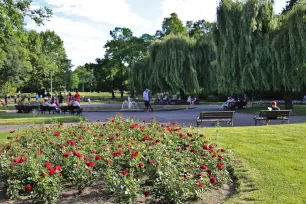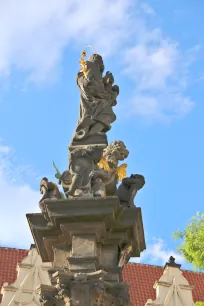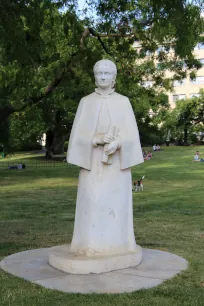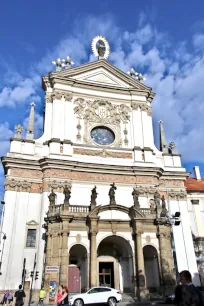In the Middle Ages, when it was a cattle market, this square was the largest town square in all of Europe. Today, Charles Square is a park laid out in the style of an English landscape garden, dotted with statues celebrating prominent personalities.
A Cattle Market…

In 1348 Emperor Charles IV launched an ambitious urban development plan in Prague: he created a whole new town, called Nové Město (New Town). It was three times larger than the old town and contained three large market squares: a cattle market (now Charles Square), a horse market (now Wenceslas Square) and a haymarket (Senovážné náměstí). Of these, the cattle market was the largest, measuring 530 meters long and 150 meters wide (1740 x 500 feet).
In the middle of the square stood a wooden stage where, once every year in May, the Crown Jewels and the emperor’s collection of relics were displayed to the public. In 1382 the wooden structure was replaced by the octagonal Chapel of Corpus Christi. From 1437 on, this chapel also housed stone slabs with the text of the Compacts of Basel, which contained concessions made to the Hussites. The chapel was dissolved during the reign of Emperor Joseph II. It was demolished shortly after, in 1791.
Becomes a Park



Starting in the 1860s, the square was transformed into a large park. Today’s design can be attributed to the garden architect František Josef Thomayer who turned it into a romantic English landscape park with several fountains, large trees and beautiful flower beds. The oldest tree is a massive sycamore tree, which reaches a height of 17 meters (56 feet) and is estimated to be over 170 years old. Shrubbery around the edges of the park separate the resting areas from the busy thoroughfares that cut the park into three different sections.
Throughout the park are monuments and memorials that honor historical personalities. The small section in the north contains two of them. The first is a monument along Žitná street that was installed here in 1881. It honors Vítězslav Hálek (1835 – 1874), a Czech poet, with a bronze bust set on a blind arch which is flanked by two sphinxes. It was created by Bohuslav Schnirch, the artist who also created many of the sculptures on the National Theater and the Rudolfinum. The other monument stands in front of the New Town Hall. It is the oldest monument on Charles Square: a Baroque fountain with a column that bears a statue of St. Joseph holding the baby Jesus in his arms. It was created in 1698 by the workshop of Matěj Václav Jäckel, which was also responsible for the statue of St. Anne on the Charles Bridge.
In the central section of the park, near ječná street, stands a white marble statue from 1931 that depicts Eliška Krásnohorská (1847 – 1926), a Czech feminist author who is best known as the writer of the text of several opera compositions by Bedřich Smetana. The statue was created by Karla Vobišová, a sculptress who, throughout her career, created mostly female figures.
There are several more monuments in the southern section of Charles Square. On the north side of this section of the park is a bust of Karolina Světlá (1830 – 1899), a Czech author. The bronze bust was created in 1910 by Gustav Zoula after a design by Josef Fanta (known for the eponymous railway station in Art Deco style). Near the central fountain is a statue of a seated Jan Evangelista Purkyně (1787 – 1869), a renowned Czech anatomist and physiologist. This is a relatively recent statue; it was installed here in 1961. It was designed by Oskar Kozák, at the time one of the most successful Czech sculptors. Finally, at the southern end of the park stands a statue of Benedikt Roezl (1824 – 1885), a botanist who traveled around the Americas and discovered more than eight hundred species of orchid. The statue, created in 1898 by Gustav Zoula, shows Roezl holding an orchid in his right hand and a book in his left. At his feet sits a native boy with a machete in his hand. The massive pedestal they rest on sits on a dais that can be reached by a flight of stairs.
Surrounding buildings
There are several noteworthy buildings bordering Charles Square, below a selection of the most interesting ones.
Church of St. Ignatius

On the east side, the southern section of Charles Square is flanked by the long facade of the former Jesuit college. Twenty-three houses and thirteen gardens were demolished to make room for this enormous building. Next to the college, the Jesuits built the Kostel sv. Ignáce (Church of St. Ignatius). Both the college and the church were built by Carlo Lurago in 1665-1670. The tower was added later, in 1687, by Paul Ignaz Bayer. The opulent Baroque design of the church was created by Giovanni Domenico Orsi (best known for his design of the Theological Hall in the Strahov Monastery), who based his work on the example of the Gesù church in Rome, the main Jesuit church.
At the very top of the facade, above the tympanum, stands a statue of Saint Ignatius – the founder of the Jesuit order – surrounded by a halo.
The interior, as is the case with all Jesuit churches, is richly decorated with stucco and statues of cherubs and saints. The painting on the main altar was created in 1688 by Jan Jiří Heinsch and depicts ‘A Celebration of St. Ignatius’.
Faust House

On the south side of the square is the so-called Faustův dům (Faust House), officially known as the Mladotov palace. The building is the setting for the Czech version of the 16th-century legend of Faust, who had made a pact with the Devil. The association of this house with Faust – who never even visited Prague – can probably be attributed to the nature of the former inhabitants of this house.
In the 14th century this house was occupied by Count Václav, an occult priest from Oprava. Two centuries later, the famous occultist Edward Kelley lived here under the patronage of Rudolf II. Kelley had promised him he could turn metal into gold. However, when he failed to produce any gold, he was imprisoned by the emperor. The list of mysterious owners grew once again in the 18th century, when this was the home of Josef Mladota of Solopysky, who conducted chemical experiments here.
A local legend tells the story of a poor student who, one winter evening, went into the house looking for lodging. He disappeared – the devil had taken him away through a hole in the roof, the same hole through which Faust was taken. Some say the hole is still there.
New Town Hall

On the opposite end of Charles Square stands Novoměstská radnice, the Town Hall of Nové Město (New Town). The town hall occupies the entire north side of the square. The eastern and oldest part was originally built in 1377 around an arcaded courtyard. It was remodeled and expanded several times, but remains one of the finest Gothic buildings in the city. The 65.5-meter-tall (215 feet) tower, decorated with coats of arms, was added later that century. The western part of the town hall was long used as a prison.
The building is best known as the site of the first Prague defenestration. On July 30, 1419, the Hussite preacher Jan Želivský urged his followers to march from the Church of Our Lady of the Snow to the New Town Hall to demand the release of Hussite prisoners. When the councilmen refused, they were thrown out of the window (or, in other words, defenestrated). This marked the start of the Hussite Wars.

